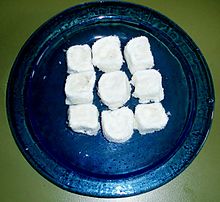Turkish delight
The confection is often packaged and eaten in small cubes dusted with icing sugar, copra, or powdered cream of tartar to prevent clinging.[8] Similar Arab and Persian recipes, including the use of starch and sugar, predate Bekir by several centuries.Its name in various Eastern European languages comes from Ottoman Turkish lokum (لوقوم) or rahat-ul hulküm.Turkish delight was introduced to European portions of the Ottoman Empire under its rule and has remained popular.[citation needed] Fry's Turkish Delight, created in 1914,[24] is marketed by Cadbury in the United Kingdom, Ireland, Australia, South Africa, Canada and New Zealand.[25] Hadji Bey was an Armenian emigrant to Ireland who in 1902 set up an eponymous company – still in existence – to produce rahat lokoum for the Irish and later UK markets.[31] Sales of Turkish delight rose following the theatrical release of the 2005 film The Chronicles of Narnia: The Lion, the Witch and the Wardrobe.[32]Turkish delight holds deep cultural significance in Greece, Turkey, Iran, and across the Middle East and Eastern Europe.In Turkey, lokum is a staple during festive occasions such as weddings, where it symbolizes sweetness and prosperity in the couples' life together.







Lokum (disambiguation)Turkish Delight (disambiguation)IstanbulConfectionSafavid IranPersiaOttoman EmpireTurkeyRoom temperatureStarchconfectionsrosewatermastic gumbergamot orangecinnamonicing sugarcream of tartarKaymakAfyonkarahisarGreeksIraniansConstantinopleKastamonuPersianThe Oxford Companion to FoodByzantine timesGreeks of Asia MinorOttoman TurkishSaudi ArabiaAlgeriaTunisiaKuwaitLebanonPalestineCyprusArmenianAssyrianBosnia and HerzegovinaIsraelSerbo-CroatianIndian subcontinentBombay halwaHungaryArmenialokhumcardamommatzoonpowdered sugarPatrasPatrina loukoumiaThessalonikiSerresKomotinimasticAkanésYeroskipouBulgariancornulețecozonacFry's Turkish DelightCadburyan eponymous companyBig TurkNestléChandu Halwaijelly beanWhite WitchEdmund PevensieThe Lion, the Witch and the WardrobeC. S. LewisAplets & CotletsBotan Rice CandyGyūhiGreek cuisineGumdropMasghatiTurkish cuisineMarron glacéThe IndependentOxford University PressGoogle BooksOfficial Journal of the European UnionOlver, LynneThe Food TimelineMırraPekmezRize teaŞalgamŞerbetŞıraTurkish coffeeTurkish teaFermented beveragesHardaliyeYayık ayranıBeer in TurkeyKanyakTurkish wineAdakarasıBoğazkereÇalkarasıKalecik KarasıÖküzgözüPapazkarasıBazlamaÇerkes simidiGözlemeKandil simidiKatmerLavaşPoğaçaSaj breadTandır breadKete (food)Bakla EzmesiCacıkÇiğ köfteÇoban saladDeniz börülcesi salatasıKatıkİçli köfteİmam bayıldıKabak çiçeği dolmasıKısırKokoreçLakerda